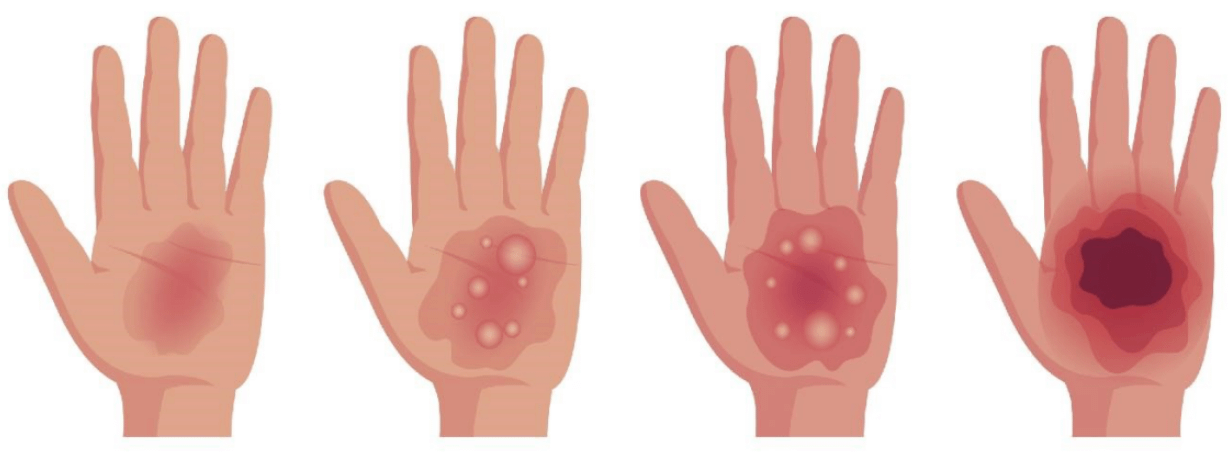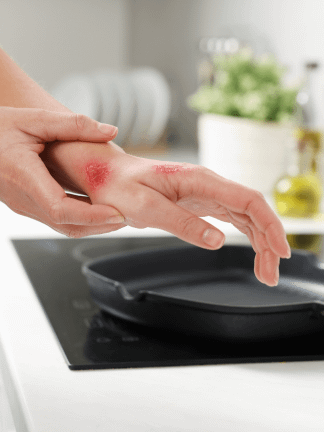Burn wounds are common injuries, especially for kids at home.1 They are not just painful; they also harm your skin, causing skin cells to die.1 Burn wounds can occur from heat, chemicals, electricity, sunlight, or radiation.2 Burns often happen from skin exposure to hot liquids and steam, fires, and flammable liquids or gases.3 Next, we'll talk about how to tell what degree your burn is, how to treat it, and when to get help from a doctor.
Key Takeaways
- Burn wounds are divided into 4 categories depending on their severity: first, second, third, and fourth-degree burns
- Burn wounds are an important cause of morbidity and mortality worldwide so it's important to learn basic first aid and know when to seek medical help
- Have antiseptics on hand such as Povidone-Iodine (BETADINE®) 10% Ointment, 10% Povidone-Iodine (BETADINE®) 5% Cream and Povidone-Iodine (BETADINE®) 10% Wound Solution to prevent infection, reduce inflammation, and promote healing

Understanding the Different Degrees of Burns: First, Second, Third, Fourth.
There are 4 types of burn wounds: first, second, third, and fourth degree.1,2 Find out how to tell how bad a burn is so you can treat it right.
First-Degree Burns
First-degree burn wounds only affect the outer layer of skin.4 The skin looks red, dry, and hurts, but doesn't form blisters. A mild sunburn is a typical example. These burns usually heal in 3 to 6 days, and there's rarely any lasting damage, though skin colour changes might happen.2,5
Second-Degree Burns
Second-degree burns affect both the epidermis and part of the dermis, causing redness, swelling, pain, and blisters.2,4 They can be shallow or deep, with shallow burns healing in under 3 weeks without surgery, while deeper ones take longer and may require surgery.5
Third-Degree Burns
Third-degree burns go deep into the skin, damaging the top and deeper layers.2,6 Since the nerves are destroyed, you won't feel anything in that area.2 Small third-degree burns can heal with scars, but big ones may need skin grafts. These burn wounds have a high risk of getting infected.4
Fourth-Degree Burns
Another type of burn is the fourth-degree burn. This affects not only all layers of the skin, but also the muscles and bones underneath. It has all the signs of a third-degree burn; however, it leads to a loss of the burned tissue.4
Burn First Aid: What to Do When You or Someone Else Gets Burned
If you or a member of your family suffers a minor burn follow these steps to provide first aid:7,8
- Remove jewellery or clothing from the affected area before it becomes swollen
- Soothe the burn:
- Run cool (not cold) water over it for 10 to 20 minutes
- Use a cool, damp cloth for facial burns
- Use ice for mouth burns
- Cleanse the wound using an antiseptic solution – e.g. Povidone-Iodine (BETADINE®) 10% Wound Solution to help prevent infection and inflammation
- Avoid bursting blisters; if one pops, carefully clean the area with water and apply an antibiotic cream – e.g. Povidone-Iodine (BETADINE®) 5% Cream
- Apply wound dressings with antiseptic burn ointment – e.g. Povidone-Iodine (BETADINE®) 10% Ointment to help prevent infection, and promote healing
- If needed, take a painkiller for relief
The Importance of Seeking Medical Attention for Severe Burns
It's important to prevent burns because most of them can be avoided.6 If a burn is really bad, make sure to get medical help because it could get infected. Infections are a big deal for burn patients and can cause serious problems, with about half of burn-related deaths happening because of infections.6,9
If you notice any of the following signs, it is crucial to seek medical help immediately:7,10
- Burns covering an area larger than the person's hand
- Burns penetrating deep into the skin
- Burns that cause the skin to be dry and leathery
- Burns that may appear charred or have patches of white, brown or black
- Burned areas that begin swelling very quickly
- Burns occurring on sensitive areas such as the face, neck, hands, feet, joints, or genitals
- Burns caused by chemicals, electricity, or are accompanied by smoke inhalation
- Additional wounds requiring medical attention
- Signs of shock such as cold and moist skin, sweating, rapid and shallow breathing, weakness, or dizziness
If symptoms persist, consult your doctor.
ASC I0018P060325B

